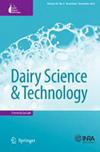基于颜色成分的非浓缩和折光窗浓缩牛奶成分及质量参数评价
Q2 Agricultural and Biological Sciences
引用次数: 5
摘要
在本研究中,建立了基于颜色成分的多元线性回归方程来测量和预测未浓缩和浓缩牛奶的质量参数。利用图像处理技术可以测量粘度、密度、pH、水分和脂肪含量。考虑到有限误差(0.00-1.12%)、标准差(0.000-0.043)和均方根误差(0.0007-0.3721),多元线性回归模型对实验数据具有较好的拟合效果。因此,这些模型可以用来预测牛奶的质量参数,包括脂肪百分比,pH值,粘度,密度和水分含量,基于未浓缩和浓缩牛奶的颜色成分。颜色变化的最大值为12.28,最小值为5.96。褐变指数预测良好,均在标准范围内。本研究中提出的非破坏性和快速程序显示了基于颜色成分评估和预测牛奶质量参数的准确性。总的来说,颜色与不同的成分和物理特性相关,并提供了一种可能的基于物联网(IoT)的方法,在未来对经过各种工艺的各种类型的牛奶进行大规模进一步评估后,可以伴随传统方法。本文章由计算机程序翻译,如有差异,请以英文原文为准。
Assessing Compositional and Quality Parameters of Unconcentrated and Refractive Window Concentrated Milk Based on Color Components
In this study, a multiple linear regression equation was developed to measure and predict quality parameters of unconcentrated and concentrated milk based on color components. The viscosity, density, pH, moisture, and fat content could be measured using image processing technology. The multiple linear regression model had a good fitting on experimental data considering the limited errors (0.00–1.12%), standard deviation (0.000–0.043), and root mean square error (0.0007–0.3721). Therefore, these models can be used to predict the quality parameters of milk, including fat percentage, pH, viscosity, density, and moisture content, based on color components of unconcentrated and concentrated milk. The maximum and minimum of color change were 12.28 and 5.96, respectively. The values of browning index were also well-predicted and were within the standard limits. The non-destructive and quick procedure that proposed in this study showed a percentage of accuracy in assessing and predicting the quality parameters milk based on color components. Overall, the color correlates with different compositional and physical characteristics, and provide a possible internet of things (IoT)-based approach to accompany the conventional approaches in the future after further evaluation at large scale for various types of milks subjected to various processes.
求助全文
通过发布文献求助,成功后即可免费获取论文全文。
去求助
来源期刊

Dairy Science & Technology
农林科学-食品科技
CiteScore
2.30
自引率
0.00%
发文量
0
审稿时长
2 months
期刊介绍:
Information not localized
 求助内容:
求助内容: 应助结果提醒方式:
应助结果提醒方式:


